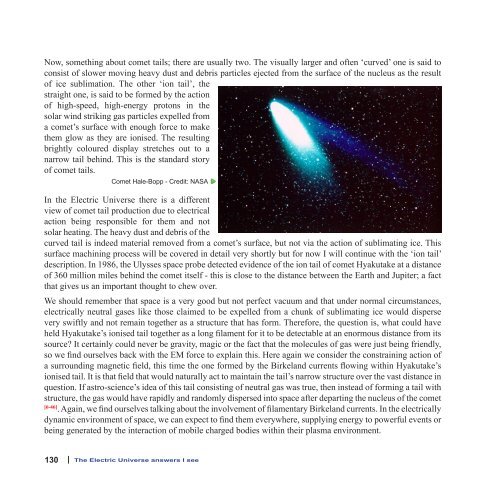A Beginner's View of Our Electric Universe - New
A Beginner's View of Our Electric Universe - New
A Beginner's View of Our Electric Universe - New
You also want an ePaper? Increase the reach of your titles
YUMPU automatically turns print PDFs into web optimized ePapers that Google loves.
Now, something about comet tails; there are usually two. The visually larger and <strong>of</strong>ten ‘curved’ one is said to<br />
consist <strong>of</strong> slower moving heavy dust and debris particles ejected from the surface <strong>of</strong> the nucleus as the result<br />
<strong>of</strong> ice sublimation. The other ‘ion tail’, the<br />
straight one, is said to be formed by the action<br />
<strong>of</strong> high-speed, high-energy protons in the<br />
solar wind striking gas particles expelled from<br />
a comet’s surface with enough force to make<br />
them glow as they are ionised. The resulting<br />
brightly coloured display stretches out to a<br />
narrow tail behind. This is the standard story<br />
<strong>of</strong> comet tails.<br />
Comet Hale-Bopp - Credit: NASA<br />
In the <strong>Electric</strong> <strong>Universe</strong> there is a different<br />
view <strong>of</strong> comet tail production due to electrical<br />
action being responsible for them and not<br />
solar heating. The heavy dust and debris <strong>of</strong> the<br />
curved tail is indeed material removed from a comet’s surface, but not via the action <strong>of</strong> sublimating ice. This<br />
surface machining process will be covered in detail very shortly but for now I will continue with the ‘ion tail’<br />
description. In 1986, the Ulysses space probe detected evidence <strong>of</strong> the ion tail <strong>of</strong> comet Hyakutake at a distance<br />
<strong>of</strong> 360 million miles behind the comet itself - this is close to the distance between the Earth and Jupiter; a fact<br />
that gives us an important thought to chew over.<br />
We should remember that space is a very good but not perfect vacuum and that under normal circumstances,<br />
electrically neutral gases like those claimed to be expelled from a chunk <strong>of</strong> sublimating ice would disperse<br />
very swiftly and not remain together as a structure that has form. Therefore, the question is, what could have<br />
held Hyakutake’s ionised tail together as a long filament for it to be detectable at an enormous distance from its<br />
source? It certainly could never be gravity, magic or the fact that the molecules <strong>of</strong> gas were just being friendly,<br />
so we find ourselves back with the EM force to explain this. Here again we consider the constraining action <strong>of</strong><br />
a surrounding magnetic field, this time the one formed by the Birkeland currents flowing within Hyakutake’s<br />
ionised tail. It is that field that would naturally act to maintain the tail’s narrow structure over the vast distance in<br />
question. If astro-science’s idea <strong>of</strong> this tail consisting <strong>of</strong> neutral gas was true, then instead <strong>of</strong> forming a tail with<br />
structure, the gas would have rapidly and randomly dispersed into space after departing the nucleus <strong>of</strong> the comet<br />
[6-46] . Again, we find ourselves talking about the involvement <strong>of</strong> filamentary Birkeland currents. In the electrically<br />
dynamic environment <strong>of</strong> space, we can expect to find them everywhere, supplying energy to powerful events or<br />
being generated by the interaction <strong>of</strong> mobile charged bodies within their plasma environment.<br />
130 | The <strong>Electric</strong> <strong>Universe</strong> answers I see


